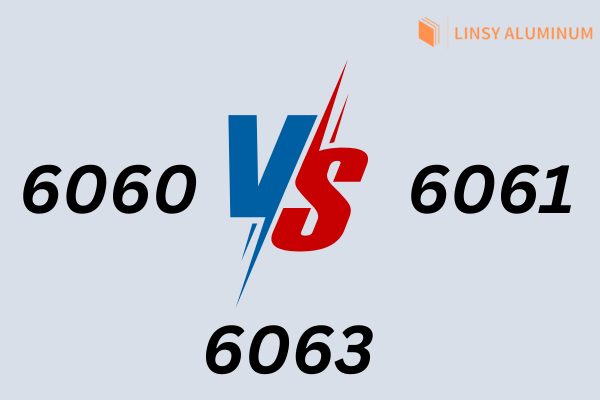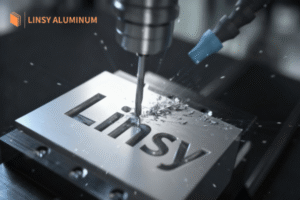Key Highlights
-
6060 aluminum alloy is known for its moderate strength, formability, and corrosion resistance, making it suitable for various applications.
-
This alloy is popular for its aesthetic appeal, especially when anodized, making it ideal for architectural and decorative elements.
-
6060 aluminum can be easily extruded, welded, and machined, simplifying the manufacturing process.
-
Its lightweight nature contributes to fuel efficiency in transportation and reduces the overall weight of structures.
-
Compared to other alloys in the 6000 series, 6060 offers a balance of strength, weldability, and surface finish quality, making it a versatile choice.

Introduction
This comprehensive guide explores the properties and applications of 6060 aluminum alloy. Renowned for its corrosion resistance and desirable tensile strength, this alloy finds widespread use across industries. We’ll explore its composition, properties, advantages, and disadvantages, providing a deep understanding of this versatile aluminum alloy.
Definition and composition of 6060 Aluminum Alloy?

6060 aluminum alloy is known for its moderate strength, good corrosion resistance, and excellent workability. It falls under the 6000 series of aluminum alloys, primarily characterized by the addition of silicon and magnesium as the main alloying elements. This alloy composition results in a material that is both lightweight and durable.
Specifically, the composition of 6060 aluminum alloy typically consists of:
-
Aluminium (97.9-99.3%)
-
Magnesium (0.35-0.5%)
-
Silicon (0.3 to 0.6%)
-
Iron (0.1-0.3%)
-
Along with trace amounts of manganese, chromium, copper, titanium, zinc, and other residuals.
Key Properties of 6060 Aluminum Alloy
|
Property |
Value |
Notes |
|---|---|---|
|
Density |
2.7 g/cm³ |
Very lightweight, typical for aluminum. |
|
Melting Point |
~600–650°C (1,112–1,202°F) |
Range varies with alloy composition. |
|
Thermal Conductivity |
200–210 W/m·K (T5/T6 temper) |
Excellent heat transfer. |
|
Electrical Conductivity |
50–55% IACS (T5/T6 temper) |
High for an aluminum alloy. |
|
Specific Heat Capacity |
0.897 J/g·K |
Energy to heat it up. |
|
Coefficient of Thermal Expansion |
23.4 µm/m·K (20–100°C) |
Moderate expansion with heat. |
|
Tensile Strength |
~145–215 MPa (T5/T6) |
Low-to-moderate, depends on temper. |
6060 aluminum exhibits properties that make it suitable for various applications. Firstly, its good corrosion resistance makes it durable in various environments, reducing the need for frequent maintenance. Its thermal expansion and conductivity are well-defined, allowing for predictable performance under varying temperatures. This is particularly important in applications where thermal cycling is expected.
Furthermore, 6060 aluminum alloy’s relatively low density makes it lightweight, offering advantages in applications where weight reduction is crucial. Its machinability also simplifies manufacturing processes, while its aesthetic appeal, especially after anodizing, makes it suitable for applications where visual appearance is important.
Applications of 6060 Aluminum Alloy
The construction industry widely utilizes 6060 aluminum alloy, particularly for architectural elements like curtain walls, window frames, and door frames. Its extrusion capabilities enable the creation of complex shapes, meeting various design requirements. Beyond construction, its lightweight and corrosion-resistant nature makes it suitable for machinery components, especially in industries where lightweight is crucial.
Moreover, the transportation sector benefits from its properties by employing it in parts for automobiles, boats, and bicycles. Creating smooth, aesthetically pleasing finishes through anodizing makes 6060 aluminum alloy popular for decorative items and consumer goods.
Advantages and Disadvantages of 6060 Aluminum
|
Pros |
Cons |
|---|---|
|
Excellent extrudability for complex shapes |
Lower strength (~145 MPa in T5) |
|
Good corrosion resistance |
Not ideal for high-stress applications |
|
Smooth, anodize surface finish |
Limited high-temperature performance |
|
Very good weldability |
Less durable in harsh environments |
|
Cost-effective compared to other alloys |
Not as strong as 6061 or 7075 |
|
Lightweight (2.7 g/cm³) |
|
One of the key advantages of 6060 aluminum is its lightweight nature, which contributes to energy efficiency in various applications. Additionally, its good weldability simplifies manufacturing and reduces production costs. Its excellent corrosion resistance further enhances its appeal, extending the lifespan of products made from this alloy. The ability to achieve a smooth, aesthetically pleasing surface finish, particularly through anodizing, makes it suitable for applications where aesthetics matter.
However, while 6060 aluminum possesses moderate strength, it might not be suitable for applications requiring high strength. Other alloys within the 6000 series or different series might be more appropriate in such cases. It’s crucial to carefully consider the strength requirements of a specific application before selecting 6060 aluminum.
6060 Aluminum Alloy vs. Other Alloys
While 6060 aluminum alloy is a popular choice, it is essential to understand how it compares to other alloys to make informed material selections. Among the 6000 series, 6061, 6063, and 6082 are common alternatives, each possessing a distinct set of properties that make them suitable for different applications. Comparing these alloys helps highlight their strengths and limitations, assisting engineers in making optimal choices.
6060 vs. 6061 vs. 6063 Aluminum Alloy
|
Property/Feature |
6060 Aluminum Alloy |
6061 Aluminum Alloy |
6063 Aluminum Alloy |
|---|---|---|---|
|
Main Composition |
Al + 0.4% Mg + 0.5% Si |
Al + 1% Mg + 0.6% Si |
Al + 0.4% Mg + 0.7% Si |
|
Strength |
Low (MPa in T5) |
Moderate (310 MPa in T6) |
Low-moderate (241 MPa in T6) |
|
Extrudability |
Excellent (complex shapes) |
Good (less complex shapes) |
Excellent (smooth finishes) |
|
Corrosion Resistance |
Good |
Very Good |
Excellent |
|
Weldability |
Very Good |
Excellent |
Very Good |
|
Surface Finish |
Good (anodizes well) |
Good |
Excellent (best for aesthetics) |
|
Typical Use |
Window frames, furniture |
Structural parts, bikes |
Architectural trim, pipes |
6060, 6061, and 6063 are all part of the 6000-series aluminum family, but they’re built for different tasks:
-
6060 Aluminum is the lightweight champ—super easy to extrude into tricky shapes like window frames or furniture, though it’s not very strong.
-
6061 Aluminum is the tough one, with more magnesium for strength, making it great for bike frames or boat parts; it’s still workable but not as flexible for fancy shapes.
-
6063 Aluminum is the pretty—best for smooth, shiny finishes like door trims or railings, with solid extrudability but less strength than 6061. All three fight rust well (6063 are the best), and they’re easy to weld. Pick 6060 for delicate designs, 6061 for sturdy builds, and 6063 for looks that last!
When to Choose 6060 Aluminum?
This 8-point table covers the critical considerations—shape, strength, appearance, cost, weldability, corrosion, weight, and temperature—without overwhelming readers.
|
Factor |
Why It Matters |
Choose 6060 If… |
|---|---|---|
|
Shape Complexity |
6060 is top-notch for intricate extrusion profiles. |
You need complex designs (e.g., window frames). |
|
Strength Needs |
It’s built for light-duty, not heavy structural use. |
Low-to-moderate strength (~145 MPa) is enough. |
|
Appearance |
Smooth finish that anodizes well for looks. |
You want an attractive, polished surface. |
|
Cost Efficiency |
Cheaper than high-strength alloys. |
Budget is a priority. |
|
Weldability |
Easy to weld with strong joints. |
Your project involves welding. |
|
Corrosion Resistance |
Handles mild environments well. |
It’s for indoor or non-harsh outdoor use. |
|
Weight |
Lightweight at 2.7 g/cm³. |
You need a light material for the job. |
|
Temperature |
Fine for moderate heat, not extreme conditions. |
It won’t face high temperatures (e.g., >400°C). |
Heads-Up: If your project requires high strength, extreme heat resistance, or exposure to tough environments (like saltwater), look at alloys like 6061 or 7075 instead.
Conclusion
6060 Aluminium Alloy is a versatile material with various applications due to its unique properties. Understanding its composition, advantages, and disadvantages can help you make informed project decisions. 6060 Aluminium balances strength and corrosion resistance in construction, transportation, and marine industries. Consider the specific requirements of your application to determine if 6060 is the right choice for you. For more guidance on sourcing 6060 Aluminium products in the United States, reach out for quotes to find the best options that meet your needs efficiently.
Why Choose Linsy Aluminum
As one of the leading aluminum brands and a top supplier in China, Linsy Aluminum emphasizes quality and reliability in all its products. Our advanced aluminum factory in China manufactures high-performance aluminum alloys that satisfy the toughest industry requirements. Dedicated to excellence, we provide precision, durability, and tailored options to accommodate your specific project needs, establishing us as a trusted partner for businesses globally searching for exceptional aluminum solutions. GET A QUOTE
Frequently Asked Questions
How Does 6060 Aluminium Compare to Other Alloys in the 6000 Series?
Within the series aluminum family, 6060 closely resembles 6063 in terms of application but differs slightly in composition. Compared to alloys like 6061, which contains more silicon, magnesium, and copper, 6060 exhibits slightly lower tensile strength but improved cold workability. It also contains less zinc, copper, manganese, and nickel than other alloys in the same series.
What Makes 6060 Aluminium Ideal for Certain Applications?
The combination of good weldability, notable corrosion resistance, and the ability to achieve a high-quality surface finish contributes to the suitability of 6060 aluminum for specific applications. This blend of properties makes it an attractive option for projects where these characteristics are highly valued.
Can 6060 Aluminium Be Used in Marine Environments?
While 6060 aluminum offers good corrosion resistance, its suitability for marine environments requires careful consideration. Its resistance to oxidation and corrosion might not be sufficient for prolonged exposure to saltwater.
Are There Any Specific Considerations When Working with 6060 Aluminium?
When working with 6060 aluminum, special attention should be paid to its thermal expansion and thermal conductivity. Understanding these aspects is crucial during the design and manufacturing processes to ensure the dimensional stability and performance of the final product.
Where Can One Find 6060 Aluminium Products in the United States?
Many suppliers and manufacturers throughout the United States provide 6060 aluminium alloy products. Contacting metal distributors or searching online marketplaces for “aluminium alloy suppliers” can help locate specific 6060 products, from raw materials to finished machinery and curtain walls extrusion components.













